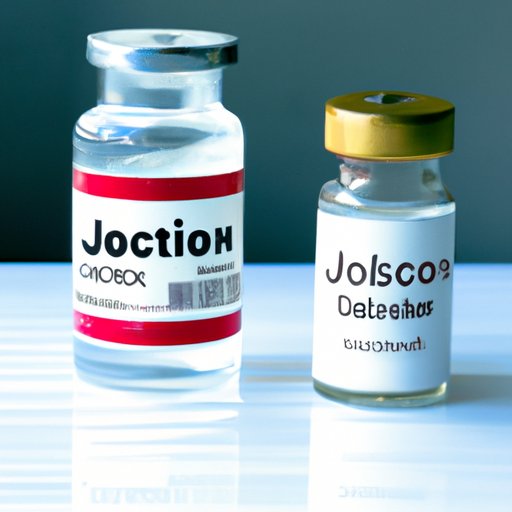Introduction
The Johnson & Johnson (J&J) vaccine is a single-dose COVID-19 vaccine that was approved by the U.S. Food and Drug Administration (FDA) in February 2021. It is the third vaccine to be approved for emergency use in the United States and offers another option to help protect against the virus that causes COVID-19. This article will explore the benefits of the Johnson & Johnson vaccine, as well as the science behind it, how it is administered, potential side effects, what to expect after receiving the vaccine, and the cost associated with it.
Exploring the Benefits of the Johnson & Johnson Vaccine
The Johnson & Johnson vaccine has several benefits compared to other available vaccines. According to the Centers for Disease Control and Prevention (CDC), the J&J vaccine is 86% effective at preventing severe disease, including hospitalization and death, from 28 days after vaccination. The CDC also notes that the vaccine is 100% effective at preventing COVID-19 related deaths from 28 days after vaccination. In comparison, the Pfizer-BioNTech vaccine is 95% effective at preventing severe disease, while the Moderna vaccine is 94.1% effective.
In addition to being highly effective, the Johnson & Johnson vaccine has a favorable safety profile. Clinical trials showed no serious safety concerns and the most common side effects were pain at the injection site, fatigue, headache, muscle aches, and nausea. These side effects are similar to those reported with the other two FDA-approved vaccines.
Finally, the Johnson & Johnson vaccine offers the convenience of only needing one dose. This makes it an attractive option for people who may have difficulty getting to a clinic or pharmacy for a second dose of the Pfizer-BioNTech or Moderna vaccines. It also makes it easier to vaccinate large groups of people quickly and efficiently.
Examining the Science Behind the Johnson & Johnson Vaccine
The Johnson & Johnson vaccine is a viral vector vaccine, which means it uses a harmless virus to deliver genetic material from the SARS-CoV-2 virus into human cells. This genetic material then instructs the cells to produce proteins that mimic the virus, which triggers an immune response. The immune system then learns to recognize and fight off the real virus if it is encountered in the future.
The Johnson & Johnson vaccine contains a weakened version of a common cold virus called adenovirus type 26 (Ad26). This virus has been modified so that it cannot replicate inside the body, making it safe to use. The Ad26 virus carries the genetic material from the SARS-CoV-2 virus, which instructs the body to produce the spike protein that the virus uses to enter and infect cells. The body then produces antibodies to this protein, which provide protection against the virus.
How the Johnson & Johnson Vaccine is Administered
The Johnson & Johnson vaccine is given as a single shot into the upper arm muscle. Unlike the Pfizer-BioNTech and Moderna vaccines, which require two doses, the Johnson & Johnson vaccine requires only one dose for full protection. The vaccine is given in a 0.5 mL dose and can be stored in a regular refrigerator for up to three months.
Potential Side Effects of the Johnson & Johnson Vaccine
Like all vaccines, the Johnson & Johnson vaccine can cause side effects. Common side effects include pain at the injection site, fatigue, headache, muscle aches, and nausea. These side effects usually go away within a few days and do not require treatment. Rare but serious side effects include allergic reactions, blood clots, and Guillain-Barre Syndrome.
If you experience any symptoms after receiving the Johnson & Johnson vaccine, it is important to call your doctor right away. Your doctor can assess your symptoms and determine if they are related to the vaccine or something else.
What to Expect After Receiving the Johnson & Johnson Vaccine
After receiving the Johnson & Johnson vaccine, it is important to monitor your symptoms and contact your doctor if you experience any adverse reactions. You should also make sure to keep your follow-up appointment with your doctor to ensure that you are responding to the vaccine correctly. Your doctor will be able to answer any questions you may have about the vaccine and provide additional information on how to stay safe.
Understanding the Cost of the Johnson & Johnson Vaccine
The cost of the Johnson & Johnson vaccine varies depending on your insurance coverage. Most insurance plans cover the cost of the vaccine and there are no out-of-pocket costs for those who are uninsured. However, some states may charge an administration fee for administering the vaccine. It is important to check with your insurance provider to find out what is covered and what out-of-pocket costs may apply.
Conclusion
The Johnson & Johnson vaccine is a single-dose COVID-19 vaccine that offers a convenient and effective way to protect against the virus that causes COVID-19. It is highly effective at preventing severe disease, including hospitalization and death, and has a favorable safety profile. The vaccine is administered as a single shot into the upper arm muscle and may have a small administration fee depending on your insurance coverage. Although there are potential side effects, these are typically mild and go away within a few days. Overall, the Johnson & Johnson vaccine is an excellent option for those seeking protection against COVID-19.
(Note: Is this article not meeting your expectations? Do you have knowledge or insights to share? Unlock new opportunities and expand your reach by joining our authors team. Click Registration to join us and share your expertise with our readers.)
